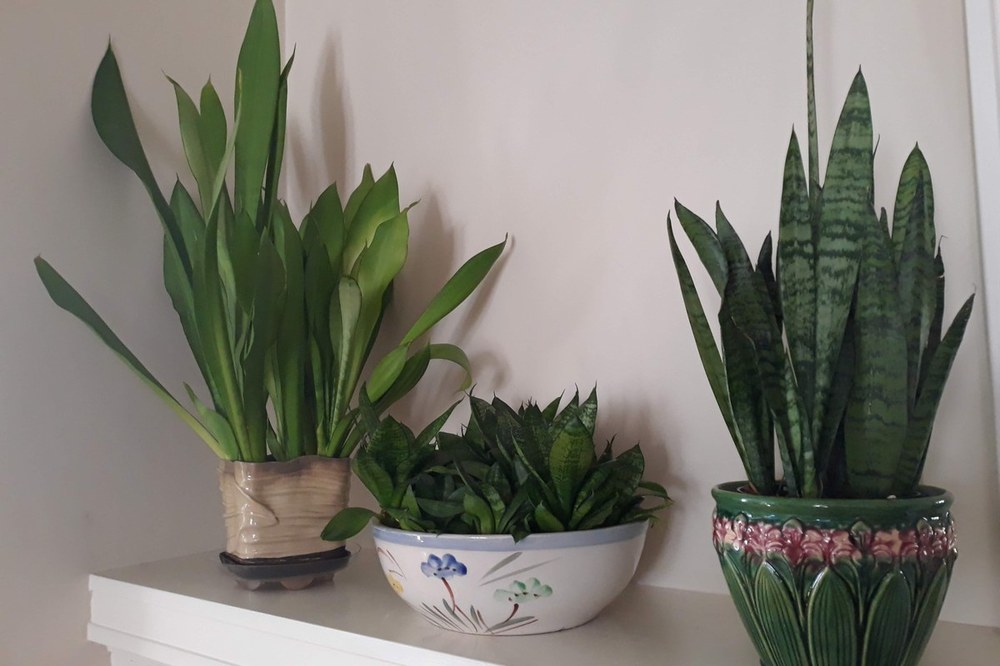Posted: January 15, 2025
Snake plants are perfect beginner house plants.

Snake plants pictured in three varieties
Snake plant is a long-lived, unfussy, succulent houseplant also known as mother-in-law’s tongue. Having historically been in the genus Sansevieria, with the advancement in genetic research snake plant has been reclassified into the genus Dracaena. The genus Dracaena also includes such commonly known houseplants as Madagascar dragon tree, corn plant, and lucky bamboo. They hail from Africa, southern Asia, and Madagascar. There are more than 70 species of snake plants exhibiting a range of height, leaf width, and form, as well as interesting variegation.
Snake plants are perfect beginner house plants. They need well-drained soil and will tolerate low-light areas. Plants thrive best in bright indirect light. Avoid direct sunlight as leaves can burn. To ensure proper drainage, choose a cactus potting mix or one with added perlite or grit. Water plants when the soil is dry. You can kill snake plants by overwatering. If you forget to water plants for a month or so, they will be no worse for wear. Choose containers with drainage holes to prevent soggy soil.
Taller varieties are best in heavier pots as the weight of the leaves can topple the plant over, especially when the soil is dry. Plants don’t mind being snug in their containers, but beware that they can break a clay pot if they become rootbound.
Dust the leaves occasionally. If there is damage to a particular leaf, remove it by cutting it off at the soil level. For a more robust plant, fertilize monthly during their growing season (spring and summer) with an all-purpose fertilizer at half strength.
Few pests and diseases bother this tough plant. Root rot is the most common affliction, especially if plants are overwatered. Mealybugs and spider mites occasionally bother snake plants.
Snake plants make great pass-along plants, as they are easy to propagate. This can be done with leaf cuttings, but plants are most easily propagated by division. Look for offspring alongside the mother plant. Remove the plants from the container, divide them, and repot with new soil. Provide fresh potting media every 5 years or so.
I have had a Dracaena trifasciata for more than 20 years. I have only repotted it once, 15 years into its life in my home. However, my Dracaena trifasciata 'Hahnii' must be repotted every 3 years. I have gifted dozens of snake plants.
If you have a pet, please note that all species of snake plant are toxic as they contain saponin toxins.
With the increased popularity of the snake plant, different varieties are common at your local garden center or through shopping online.
Dracaena trifasciata has long, strong upright swordlike leaves that end in a point. Happy in the corner of a room, table, or shelf, they provide an excellent vertical accent or architectural statement, not spreading out much beyond the perimeter of the container. The straight species has green leaves with darker green, irregular, horizontal variegation, and can grow up to 4 feet tall. The striping of the leaves is the origin of its common name, snake plant. This species was formerly Sansevieria trifasciata. Look for the following cultivars:
- 'Laurentii'- bright yellow/golden bands along the margin of the variegated green leaves.
- 'Moonglow'- broader silvery-green leaves with a narrow dark green band along the leaf margin.
- 'Bantel's Sensation'-vertical white striping in the leaves, which grow to 36 inches tall. The leaves are narrower than most cultivars of the species, at 1 to 2 inches.
- 'Hahnii'- a dwarf rosette species growing to only 6 inches. The common name is "bird's nest snake plant." This cheery plant can grow in a low bowl and is small enough for your desktop, coffee table, or bookshelf.
- 'Golden Hahnii'- another dwarf rosette whose leaves sport a broad golden band along the margins. It grows up to 7 inches.
Dracaena angolensis is an interesting species with rounded tubular stems that end in a sharp barb. It is also called "spear snake plant" or "cigar snake plant." Some plants in this species can spread up to 3 feet beyond the perimeter of the container. This species deserves the space to be a focal point. Dracaena angolensis var. patula 'Boncel', the starfish snake plant, spreads from its base like a fan on one flat plane. It has thicker and shorter leaves than the straight species.
Dracaena hanningtonii 'Samurai Dwarf' is a slow-growing cultivar reaching a maximum height of 6 inches. The leaves are thick, short, V-shaped, and have red edges. They arise from the stem in an alternating pattern, creating a circular form when viewed from above.
Dracaena pethera 'Coppertone' is procumbent rosette variety, broader than it is tall. Its wide wavy-edged leaves are variegated dark green and copper. It grows to 8 inches in diameter.
Dracaena pethera 'Silver Blue' has stiff blue-grey variegated foliage with red and white tinges. The leaves are 4 inches wide and up to 12 inches long.
Dracaena bacularis 'Fernwood Mikado' has narrow, upright, dark green variegated leaves. It becomes dense as it matures. The plant provides a beautiful presence on a desk or table. It is a favorite of mine.
Dracaena masoniana is also called "shark fin" or "whale fin" due to the wide paddle-like leaves that can grow up to 10 inches wide and 4 feet long. The dark green leaves have attractive white blotches and purple margins. It is striking.
Whichever snake plant you choose to bring into your home, it will provide years of interest with minimal care.
Susan Marquesen is a Penn State Master Gardener. This volunteer program supports the outreach mission of Penn State Extension and provides research-based information on best practices in sustainable horticulture and environmental stewardship. For more information, contact the Penn State Extension of Allegheny County at alleghenymg@psu.edu or 412-482-3476

